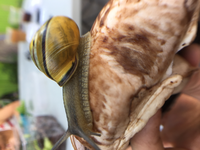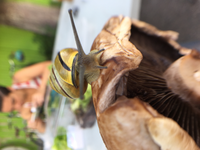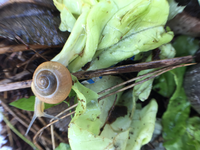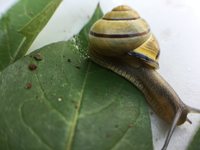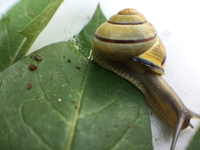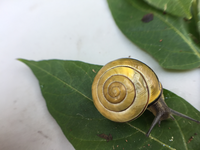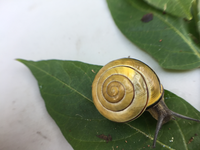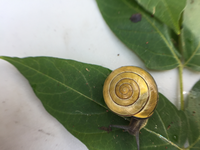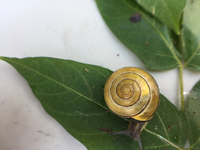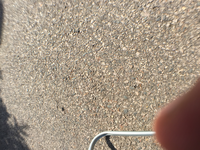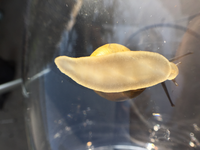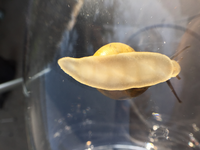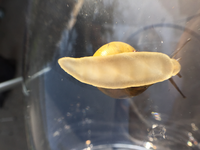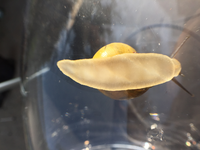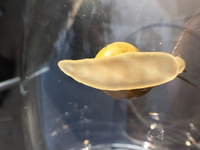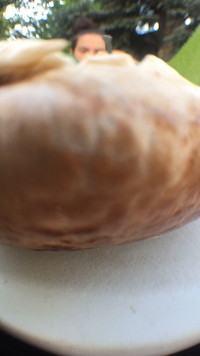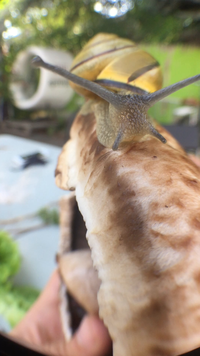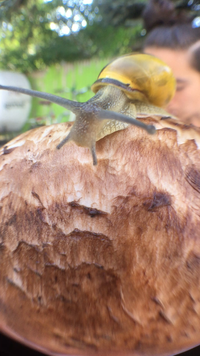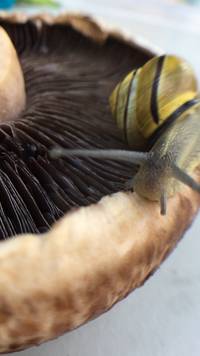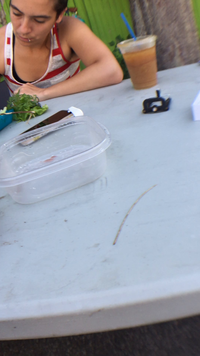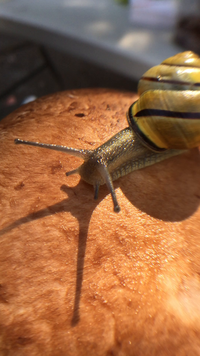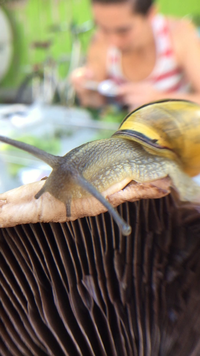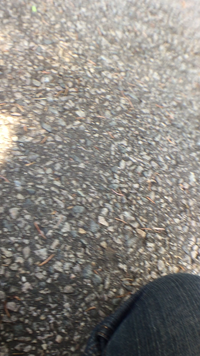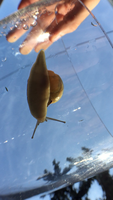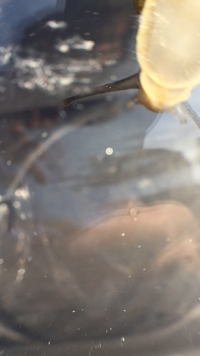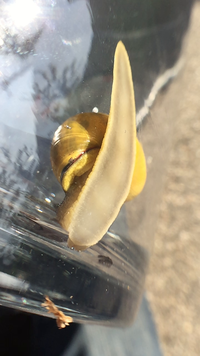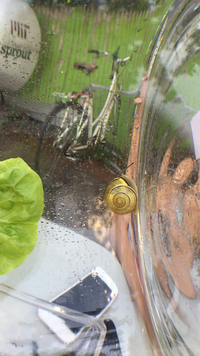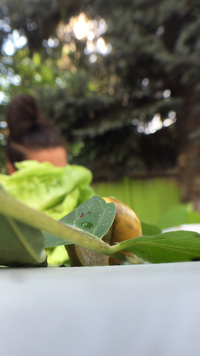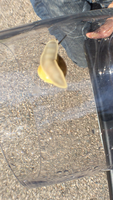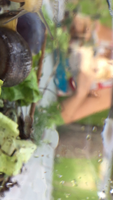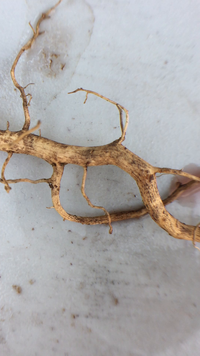How does a snail move?
The way snails move turns out to be pretty unusual. We're going to try to understand it by analogy— First thinking about ourselves, then inchworms, then earthworms, before finally looking at an actual snail. But before we get to any of that, let's start with thinking about how things move, period—
So how do things move? Well, every thing has weight. Because it has some weight, to move it we have to push on it. But how do we push on it? Weirdly, the only way we can push on something is by pushing on something else, and having that something else push back on us.
What?
Well, think about how you walk. Imagine you're just standing there.
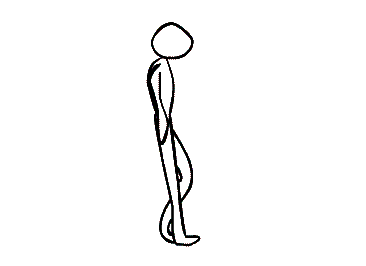
How do you take a step?
Well first you lift your foot.
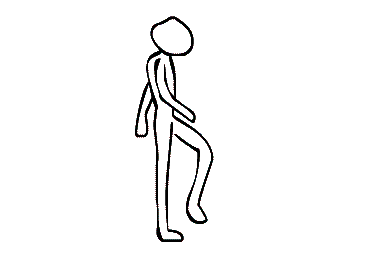
Then you move that lifted foot forward, moving your whole body a little bit forward at the same time.


When you moved your leg forward, you had to "push" on something. Imagine floating in space and taking a step. Your leg would move, but you wouldn't.
Why not? Well, because when you take a step without actually standing on anything, you're just moving your legs around.
Imagine one of your feet is "stuck" to the earth; when you try to move your other leg, your stuck leg doesn't move. So not only does your other leg move forward, but the rest of your body is pulled/pushed along with it.
Then what happens? Your lifted foot hits the ground and it gets stuck.



Then, you lift your back foot, and move it forward— Now, your front (stuck) foot is pulling your back leg (and body) forward.



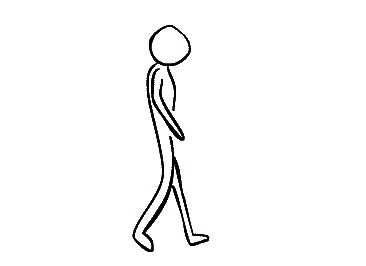
Then, your back foot hits the ground, becomes the front foot, and the whole process starts all over again. And then you're walking!

So fundamentally, for something to move along the ground, we need to have it push on something, extend or move itself, grab hold further along its path, and use its new hold to move again.
It's pretty easy to see how we do this with two feet. But what if you don't have legs?
Let's think about an inchworm. An inchworm doesn't have legs, right?
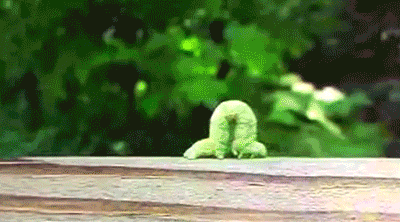
Well if we look up close at an inchworm, we see it actually kind of does— An inchworm keeps its rear "legs" stuck, then stretches itself forward,
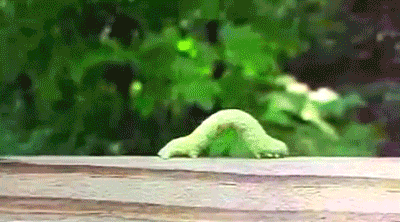
then sticks its "front" legs, lifts its "rear", squinches up,

and repeats.
So that's how the inchworm moves.
And actually, it's pretty similar to how an earthworm moves…
…except an earthworm doesn't really squinch up in the same way. Earthworms can shorten and lengthen different parts of their body because of some amazing plumbing they have inside of them. This plumbing lets the earthworm stretch different parts of themselves longer or shorter, all along its body.
But, if the earthworm doesn't squinch up and down in the same way, what makes parts of it stick and parts of it slide? Unlike the inchworm (which just puts its body on the ground to stick/lifts it to slide), the earthworm has these amazing bristles along its whole body which it can extend and retract. If we look at a slice of the earthworm, it looks something like this…you can see the bristles indicated by the arrow:
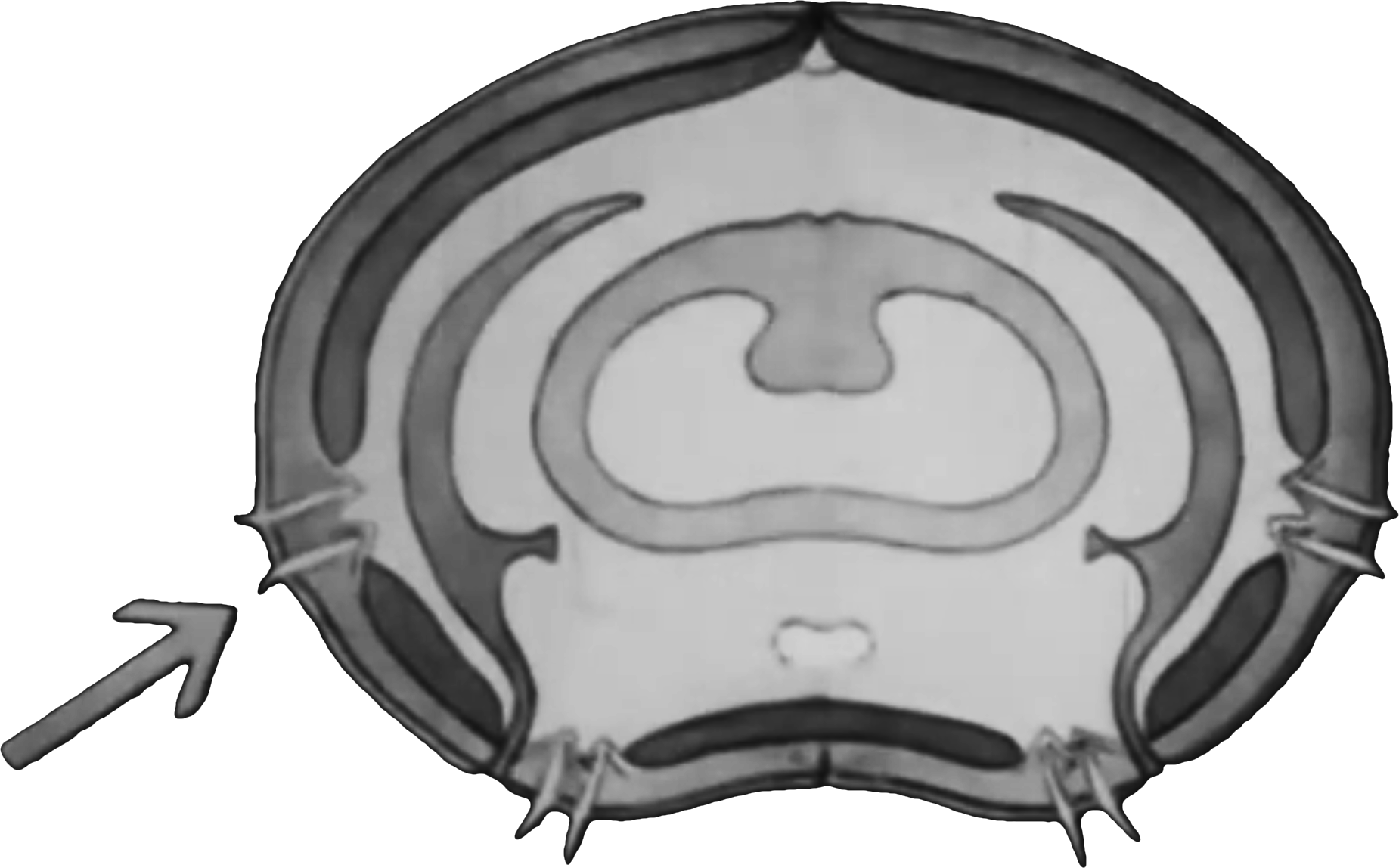
And the earthworm extends its bristles in the part of its body which its contracting, and retracts them where its body is extending.
So, it grabs the surrounding soil and pushes off of it, contracting and extending as it pulls and pushes its way through soil.
This is something else that's different than our inchworm— the earthworm has many "feet" (for our purposes, a foot is just the thing that sticks to the ground that we push off of). Just to make sure we understand, let's try to take this back to our inchworm. Here's a simple line-animation of how I think an inchworm moves— its "feet" are the parts that stay in contact with the ground (which I haven't drawn here).
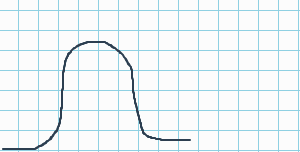
The earthworm has a ton of "feet". But for now, let's start just by imagining an inchworm with two humps instead of one. (Or, if it's less weird for you, imagine two inchworms, where one inchworm's head hangs onto the other one's butt.)

If our two humped inchworm were to squinch up its humps and move the parts of the inchworm which are stuck on the ground, we'd have a three-footed inchworm.

With that, you can imagine how we might go through a similar exercise to make a four- or five- or n-footed inchworm.
OK cool. Now let's imagine something weirder. Instead of the hump squinching and stretching, imagine that the part of the worm touching the ground—the foot—"rolls" forward. Kinda like the worm doing a moonwalk, the part of the worm touching the ground doesn't slide backwards to squinch up, instead, the part of the worm touching the ground changes, shifting forward or back.
What?
Yeah, this is hard to wrap your head around.
In our current inchworm, the part of the inchworm that's the hump and the part that's the foot stay the same as it moves.

So here, for example, the green parts are the parts which scrunch. But, this doesn't have to be the case. You could imagine that an inchworm could, say, alternate which parts of its body it scrunches up, like this

But those sections we're highlighting are made up. A real inchworm (or earthworm) has dozens and sometimes hundreds of sections. You could imagine that instead of alternating sections that scrunch up, we could just slowly shift the sections which are scrunching up.
Let's look at it as a diagram.

Imagine this diagram represents an inchworm with a bunch more sections, of which, each one could scrunch. So our two hump earthworm might, for example, have been scrunching AC and FH.
So with this notation, what I meant when I said to imagine that we could shift the section which was scrunching is that maybe at first AC scrunches, then BD, then CE, and so on. And at the same time, maybe FH scrunches, then GI, then HJ. In other words, the first scrunch involves AC/FH, then BD/GI,then CE/HJ, and so on.
In this sense, the "foot" is more like a "wave" which is rolling down the inchworm. Instead of sections, imagine the inchworm as continuous—i.e. where every part of the work could be a foot—and you imagine hundreds or thousands of sections…kind of like a wave in a rope.
You can see this in lots of other places too. People can do stomach rolls, for example:
Or body rolls:
Or the worm:
But what ties them all together is the wave traveling through a medium—our body. You can imagine a bit more clearly what this looks like for a worm if we look at a bigger wave moving through something that looks like a worm…e.g. a rope.
While that's a video of a wacky exercise, imagine that the rope was sticky and made of muscle, so that as the part of the wave touching the ground moved, the rope was also pushing against the part of the wave touching the ground.
Well incredibly, this is roughly how the snail works— This is what I meant when I asked you to imagine those humps rolling instead of lifting.
Except, we still have a couple questions to answer in this analogy. One of them is that a snail doesn't lift off the ground. An inchworm is lifting its body off the ground to reduce friction in some places. Those humps can push against its "feet" which are touching the ground.
The snail's body stays in contact with the ground the whole time. So what gives?
Well, it turns out that the snail can do something like the earthworm. Remember how the earthworm could extend bristles out of part of its body to grab the dirt around it, and use that kinda like claws to push and pull its way through the soil? Snails can do something kind of like that— except instead of controlling bristles, snails control how sticky different areas underneath it are. That's actually what you're seeing in those waves in that earlier video of the underside of a snail…
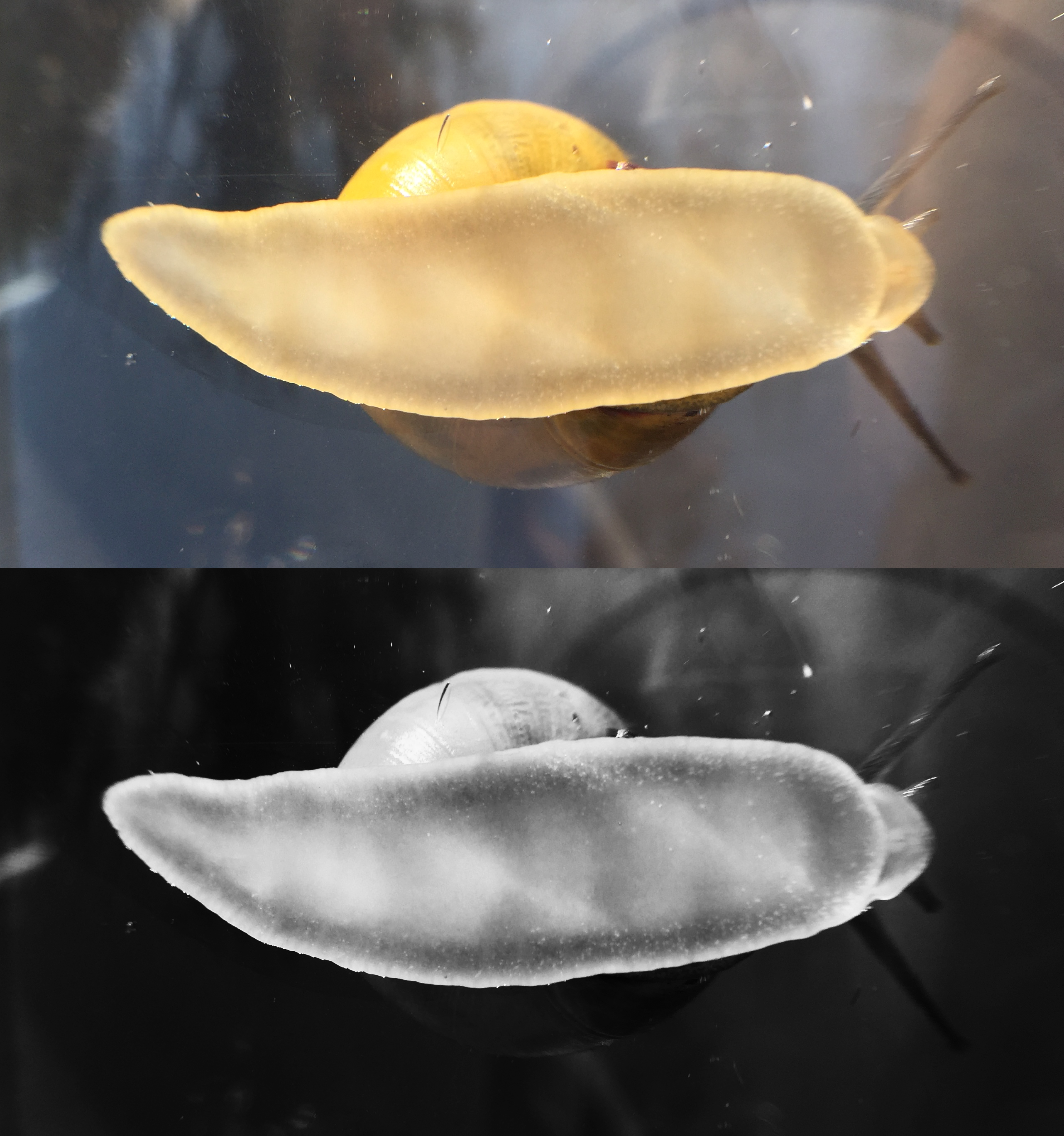
The dark parts of the snail are less sticky than the light parts. And that's all due to its slime.
It turns out the slime snails make is pretty special. There are actually two types of slime (that help lubricate and stick to things, respectively), and there are still plenty of open questions of exactly how the slimes work. But for our purposes, the most important thing to know about the slime that's underneath the snail is that when you push on it or squeeze it, it gets less viscous.
Roughly, that means that it acts like it's "less thick," or "thinner".
You know how it's easy to move your hand through water, a bit harder to move it through paint, even harder to move it through mayonnaise, and even harder than that to move it through peanut butter? That's viscosity. It's how much a fluid resists changing its shape when you push on it.
Most fluids that we're familiar with resist the same amount no matter how hard we're pushing on it. But some fluids change depending on how hard you push. They're called "non-Newtonian" for reasons that don't really matter to us.
Some get thicker—like oobleck, if you've played with that before. Those are called "shear thickening". That roughly means that when you apply a force, the liquid gets thicker (i.e. more viscous).
Weirdly, there are some fluids which actually get less viscous when you push on them. Those are called "shear-thinning". This is the type of fluid snail's slime is. And this is the secret to the snail's motion. Incredibly, people don't understand what makes the slime shear thinning.
OK, so snails have this wild slime that gets thinner when we squeeze it. Cool. But how does the snail squeeze it? It turns out people don't totally know, but they think there are at least two things happening with the snail's muscles which squeeze the slime. The first involves yet another set of waves: the muscles on its rim, around the center of its underside, squeeze inward, toward the center, pinching the slime. You can see that oscillation moving around the rim of the snail's foot if you look closely…if you watch the very edge of its rim, you'll see it looks like there are waves traveling around it.
The second is that kind of like the earthworm, the snail's body itself stretches in some places and contracts in others, and because the slime sticks to the body, this squeezes the slime in the other direction.
Together, if you look closely at the perimeter of the snail, you'll see that there's kind of this oscillation traveling around the edge of the snail and the whole snail is kind of puckering up and then expanding, pulsing.
The incredibly coordinated movement of these muscles is what creates those waves of sticky and less sticky slime.
But…here I have to pause and admit that I lied when I said the snail controls how sticky its underside is. It's really about how viscous it is. Stickiness doesn't have anything to do with that. Super glue is very sticky, but not viscous at all. Elmer's glue is way less sticky, but much more viscous.
It would be simpler if this was just about how sticky the slime is. And the snail's slime does keep it stuck to the ground. That's what lets it slide up walls or upside down. But that stickiness isn't what lets it do what our inchworm does—keep in mind, we're trying to figure out how the snail "pushes" on some parts of its body and not others, if it's not lifting its body like the inchworm.
If it was about how sticky the slime was, that would work: because some parts were sticky, that part of the body would be "more stuck" to the ground than another part, and so the next part of the snail could push against it. This is the whole idea behind our multi-humped/rolling inchworm thinking.
But Nature's one level more complicated than that. The slime doesn't get stickier, it gets more viscous. The snail "pushes off" these thicker blocks of slime, stretching out the parts of its body which are atop the "thinner" blocks.
In other words, what happens is that the snail's muscles squeeze the slime in this wacky, traveling wave. In some places that makes the slime thicker. This means that when the snail stretches its muscles above the parts which are thinner, it can "push" against the parts which are connected to the surface by the more viscous fluid, i.e. the thicker parts. These different muscle contractions producing waves are coordinated—as the snail stretches, it's also squeezing a different part of the slime, shifting area of the blob of slime which is thicker up while pushing against it.
In this way, the snail has a handful of thicker blobs which it rolls up its body, stretching its body and pushing against those thicker blobs in a rolling wave, like a weird cross between that rope we saw, an earthworm, an inchworm, and an otherworldly magical glue (i.e. snail slime).
It's reasonable to ask: Why does the snail need all this slime in the first place? Why can't it just push on the ground directly? Well, there are at least two pieces to that.
The first is that unlike the inchworm, the snail is in contact with the ground the whole time. If it didn't do this slime-stretching wackiness, it would need to lift parts of its body off the ground. That's a big deal. The snail's slime also lets it travel over a very wide variety of surfaces—sticky and sharp and rough and smooth. But it only lets it do that if it adheres to the surface, and that's best served by having as much surface area in contact with the surface as possible (kinda the way it takes more effort to pull off a big, glued down thing than a small one).
OK, that's about as much as I really understand right now. You can take a look at the other resources I found useful in understanding snail locomotion below, or some of the other questions which came up while observing snails.
Note that some of the additional research materials explain other elements of snail locomotion (like the relative speed of the waves of viscous slime compared to the snail speed overall, the different explanations for what makes the slime get thinner when the snail squeezes it, etc.). I tried not to include anything here which I didn't feel like I really understood, but there are some good bits and pieces for future investigation worth checking out, if you find yourself interested.
